9 December, 2003
The Side Crater
Dr. Kurt Panter, from Bowling Green State University in Ohio, and his
undergraduate student, Brian Winter, are working on Erebus’s side crater
this season. Currently inactive, this smaller, lower crater (Figure 1)
has not been studied in detail before, so Brian is mapping the outcrops
and collecting rock samples in an attempt to interpret the volcanic
history.
As gas sampling (see 12/08/03 Pumping Station) is
important to understanding the current activity on Erebus, interpreting
historical eruptions and possible magmatic intrusions adds to our
understanding of volcanism in Antarctica.
Volcanic activity in Antarctica, New Zealand, and Australia has been
interpreted in several ways. One argument for the presence of Mt. Erebus
and related volcanoes is that the plate is rifting, or pulling, apart as
the result of extensional Plate Tectonic forces, much like the East
African Rift System (Figure 2a). This stretching and thinning of the
lithosphere (crust plus uppermost mantle) decreases the pressure on the
underlying mantle and allows it to melt. This melted mantle is more
buoyant and rises to the surface through conduits and is expressed as
volcanic activity. A contrasting theory is that a deep mantle plume
(much like the intraplate plume that feeds Hawaii) is rising to the
surface in this region (Figure 2b). There are arguments that this plume
was actually responsible for the break up of Gondwanaland (including
Antarctica, Australia, New Zealand, and Tasmania) and now continues to
feed Erebus. A third scenario suggests that an ancient spreading center,
the Phoenix Ridge, was subducted beneath the Antarctic plate. A
downgoing lithospheric slab reached neutral buoyancy and sat above the
point at which it would descend into the lower mantle. At some later
time, this slab collapsed into the lower mantle and caused an upwelling
of hot mantle, which worked its way up to the surface to cause melting
over a wide geographic area.
Understanding more about Erebus’s past activity will contribute to the
understanding of why volcanism occurs in this area. Kurt and Brian are
looking at the geochemistry of the rocks around Erebus. The chemical
signals recorded in the rocks indicate where the magma originated in the
mantle. If the magma was derived from melted mantle that sat close to
the surface and then was recycled deeper into the Earth, the signal
would look different than if the magma originated from a lithospheric
plate melted in a subduction zone. This information may help answer
questions regarding the underlying causes of volcanism as discussed above.
I accompanied the Bowling Green team on a mapping trip to the side
crater. Our route took us up the outside of the crater, along the rim,
and down into the crater to collect samples from several outcrops
(Figure 3). Kurt and Brian colleted specimens from each outcrop for
analysis in the lab (Figures 4 and 5). We found that the fastest way
down to the floor of the crater was to do a controlled self-arrest. A
self-arrest is a method of stopping a fall down a steep, snowy or icy
slope. You throw your weight over onto the head of your ice axe, which
you bury point-down in the snow. Weighting the ice axe brings you to a
stop. We intentionally slid down a steep slope and self-arrested at the
bottom before reaching rocks again. You can see our self-arrest route
along the solid line on Figure 3. While done in a safe and controlled
manner on good snow, it was a steep enough slope to get our heart rates up!
As we recovered from the excitement of our slide, we took some time to
take a look around at old lava bombs, ejected from the main crater. In
Figure 6, the lava bomb has retained its hollow core. As the lava is
ejected from the main crater (a gas slug rising to the surface and
bursting throws lava out of the lake), the gasses in the lava expand due
to decreased pressure. This expanding gas leaves a hollow center in the
bomb and creates a spindly, fibrous glassy texture as the gas continues
to expand through the lava.
After a few hours of exploring the side crater it was back to the hut
for dinner and a little ice caving before bed. In contrast to last
night’s caving adventure, tonight’s was pretty easy. Last night we had
rappelled into a brand new cave that no one has investigated before. We
were treated to the most glorious display of ice crystal formations –
everything from perfect hexagonal crystals that show multiple growth
layers to ice stalactites and stalagmites which mirror formations found
in limestone caves (Figure 7). A short climb out was made challenging by
a small overhang at the lip of the cave. Tonight’s cave, in contrast,
was a nice walk through a winter wonderland. Large rooms connected by
tighter squeezes made for adventure without the exhausting climb out. An
investigation of one tight squeeze revealed a small, low room, but
unfortunately did not lead to new passages (Figure 8).
With my fill of self-arresting and caving for the night, I slept warm in
my –55 degree down sleeping bag, one hot water bottle at my feet and one
tucked under my arm. I drifted off looking forward to packing gear up
Ray’s Gully tomorrow to help install the new seismic station.

1. Figure 1 – The side crater is located on the southwest side of the main crater.
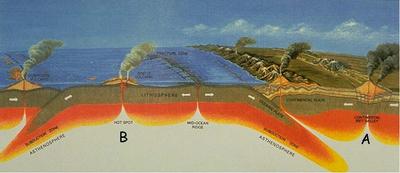
2. Figure 2 – Image depicting Plate Tectonic processes. (A) illustrates continental rifting, where a continental plate is being pulled apart, thinning the crust and allowing the mantle to melt. (B) depicts a plume or hot spot rising to the surface, resulting in volcanism. Image courtesy of SEPM (Society of Economic Petrologists and Mineralogists) Photo CD.
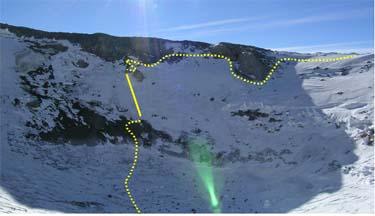
3. Figure 3 – Our route (yellow) carried us to several rock outcrops and finally to the floor of the side crater. The dotted yellow indicated where we walked with instep crampons and the solid yellow denotes a controlled slide down a snow patch with a self-arrest at the bottom.

4. Figure 4 – Dr. Kurt Panter (Bowling Green State University) discusses possible explanations for a massive, porphoritic rock layer. One possible suggestion is that this layer represents ponded lava that has cooled and hardened.
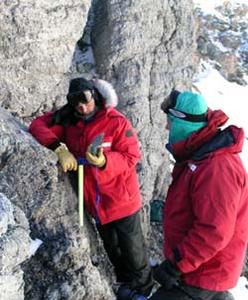
5. Figure 5 – Brian Winter, an undergraduate from Bowling Green, examines a hand sample that he will use in his research on the history of Erebus’s side crater.

6. Figure 6 – Brian Winter takes a break next to an old lava bomb, probably erupted from the main crater in the 1984 eruption.
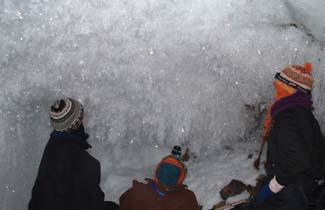
7. Figure 7 – Colleen Brogenski, Harry Keys, and Julie Calkins admire the ice crystals in “Julie’s Cave,” a newly discovered ice cave (Photo courtesy of Dawn Sweeney).
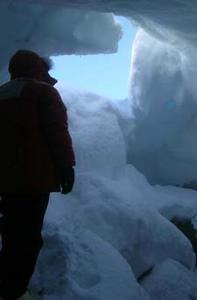
8. Figure 8 – Shauna Mikelich stands just inside an entrance to “Hut Cave.”
Contact the TEA in the field at
.
If you cannot connect through your browser, copy the
TEA's e-mail address in the "To:" line of
your favorite e-mail package.
|
